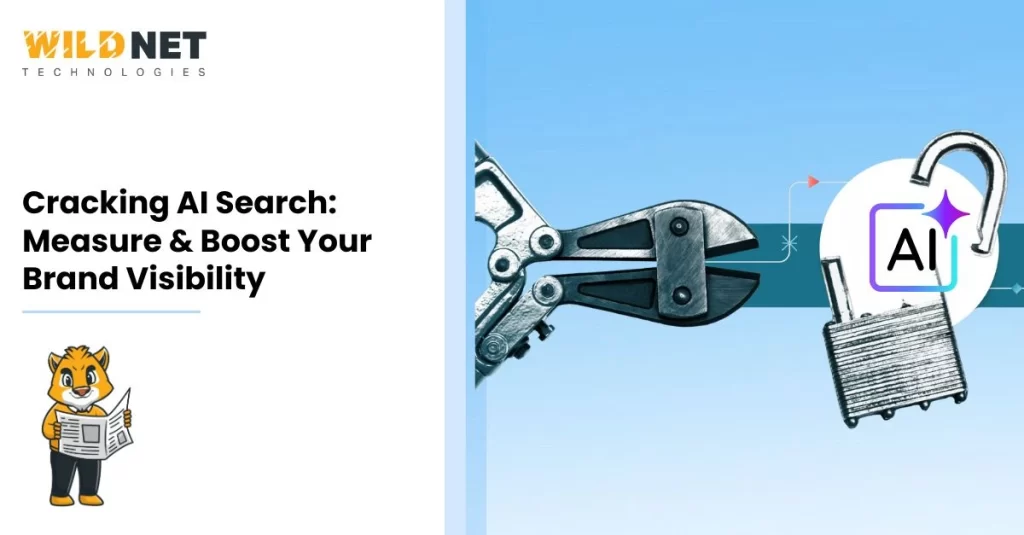Summary
AI Search is ruling the Search ecosystem and has become the latest bone stuck (alongside zero-click searches) in brands’ necks.
It uses AIs or AI-powered search engines to give summarized answers instead of links (traditional search). This makes search truly user-friendly and time saving.
While users love it, brands and marketers hate it; here’s how your brand can start enjoying AI Search….
Key Takeaways
- Visibility in AI Search isn’t about rankings—it’s about mentions, citations, and presence in AI-generated answers.
- Traditional SEO metrics (rank & clicks) are insufficient for AI-powered search.
- Use structured content, schema, and authoritative signals to improve your likelihood of being cited.
- Track performance with specialized AI visibility tools and metrics like share of voice.
- Understand core AI search methods (heuristic, deep search, adversarial & best-first) to upgrade your content strategy.
Table of Contents
- A few facts about AI Search
- Why is “cracking” AI Search harder than classic SEO?
- 4 Core AI Search techniques to know in 2025
- How to measure Visibility in AI Search?
- How can Brand Visibility be Boosted in AI Search?
- Conclusion
- FAQs
The world of search is being rewritten. With generative AI tools like ChatGPT, Gemini, and Perplexity, more users rely on synthesized answers instead of clicking through traditional links. AI Search has become a new battleground for brand visibility in this shifting landscape.
For marketers, content creators, and brand strategists, the question is no longer which keyword will rank, but how to appear in AI-powered responses.
In this blog, we explore how to crack AI Search, measuring your presence, decoding relevant AI techniques, and boosting your brand visibility in this new era.
A few facts about AI Search
- In Oct 2025, students are searching for AI solutions the most, followed by health-related queries.
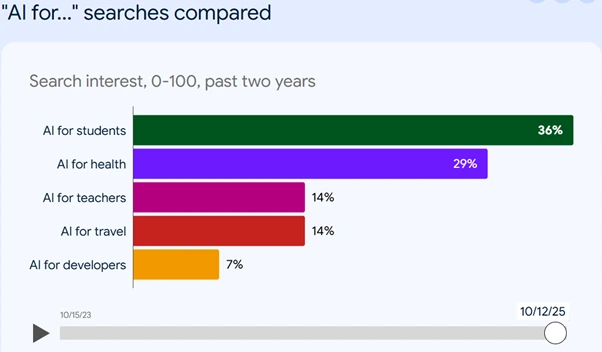
Google Searches in the USA related to the keywords “AI for”.
- ChatGPT 4.5 and o1 are the safest & responsible AI models in 2025.
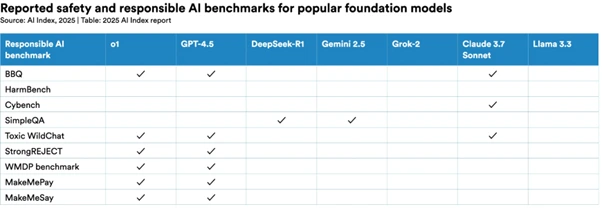
A tabular comparison of Safe & Responsible AIs as per benchmarks.
- Google still sends 345X more traffic to business websites than Gemini, ChatGPT and Perplexity combined.
- AI search results are leveraging not only the Top 10 Google Search results but are also going beyond that.
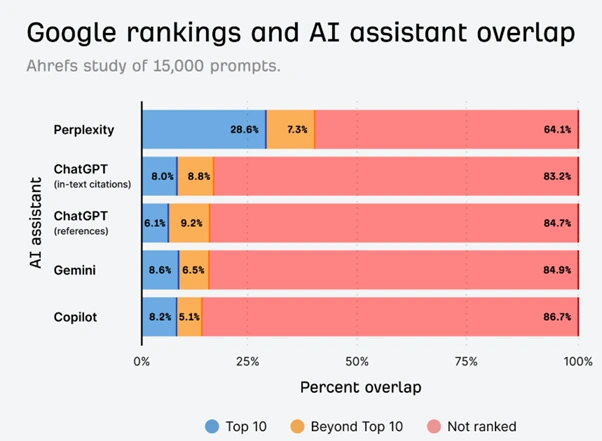
How are Google rankings used by AIs in 2025?
- AI Mode is live in India and covers Hindi, Urdu, Bengali & six other regional languages.
Why is “cracking” AI Search harder than classic SEO?
In traditional SEO, you optimize for keywords, build backlinks, monitor rankings, and aim for click-throughs. But AI Search changes the rules:
- No fixed ranking pages: AI platforms don’t commit to a sequence of results; they generate answers.
- Citation-driven logic: If your content is cited, it matters more than being ranked; then, its chances increase.
- Unpredictable formats: Responses may be paragraphs, bullet summaries, lists, or conversations.
- Opaque algorithms: AI models are black boxes; you won’t get transparent guidelines or signals.
- Dynamic queries & intent: Users ask more complex & conversational prompts (e.g. “how to search in AI?”), which demands adaptability that is not possible with simple Google algorithms.
To succeed, you must reframe the visibility question from “how high do I rank” to “how often am I surfaced or cited in AI answers.”
4 Core AI Search techniques to know in 2025
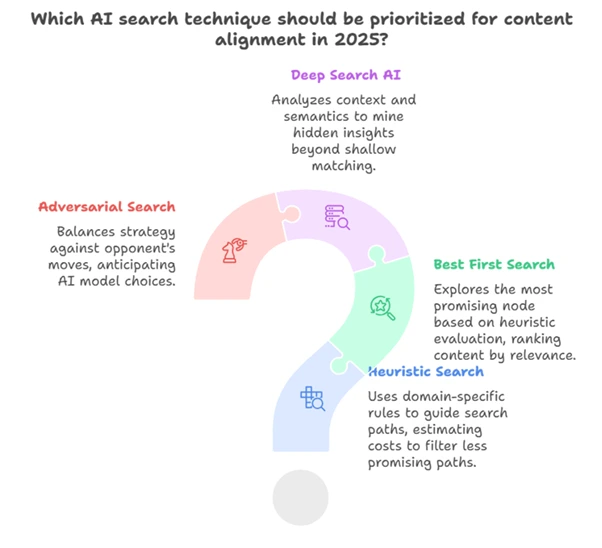
4 Core AI Search techniques
Understanding how AI models search internally can help you align your content. Below are key methods:
Heuristic search in AI / What is Heuristic search in AI?
Heuristic search is a method that uses domain-specific rules or heuristics to guide search paths toward likely solutions. In AI planning or pathfinding, heuristics estimate the “cost” or distance to a goal, helping algorithms remove less promising paths.
In content generation and knowledge retrieval, AI systems may internally use heuristic-like signals (relevance scoring) to filter candidate sources before selecting which to cite.
Best First search in AI / What is Best First search in AI?
Best first search is a graph search algorithm that explores the most promising node based on a heuristic evaluation (priority queue). It picks the “best” next node.
Some AI systems adopt a variant in which content is ranked by relevance or quality, and then the best ones are considered first for inclusion in responses or citations.
Deep search AI / What is Deep search AI?
Deep search AI typically involves exploring deeply connected or layered knowledge graphs or applying deep learning to mine hidden insights beyond shallow keyword matching. It may analyze context, semantics, and inference chains to traverse deeper into subject matter.
In AI Search, creating content that reflects deeper context, relationships, and multi-step reasoning helps make it more AI-citable in complex prompts.
Adversarial search in AI / What is Adversarial search in AI?
Adversarial search arises in game theory (e.g. minimax & Monte Carlo tree search) and focuses on balancing your strategy against an opponent’s moves.
While less directly applicable to content, adversarial reasoning matters in content strategy: anticipating how AI models choose between competing sources, and structuring content from the “winning” selection.
These four core techniques are necessary for every brand and marketer leveraging SEO in 2025 because content cannot be aligned without knowledge of AI search processes.
How to measure Visibility in AI Search?
Because traditional metrics are insufficient, here’s how to measure AI Search visibility more meaningfully. This is needed to understand your brand or client’s current standing from AI’s point of view.
Here are the 4 KPIs for AI search visibility measurement:
Mentions & Citations
These two are the basic EEAT depicters for AIs.
Mentions
The number of times your brand or content is referenced (named) in AI answers (even without links).
Citations (linked references)
It refers to the instances where AI-generated responses include a hyperlink to your content.
Mentions act as the new “impressions,” and citations are stronger signals of authority.
Share of Voice
Compare how often your brand is cited versus competitors across relevant queries. This metric shows your relative presence in AI Search conversations for a topic or keyword.
Visibility Over Time, Sentiment & Link Depth
These three KPIs or key performance indicators are crucial for charting long-term organic success in the AI era.
Visibility over Time
It tracks mentions/citations over weeks and months, spotting trends or drop-offs.
Sentiment Analysis
Sentiment analysis helps understand whether your brand/client has been mentioned with a favourable, neutral, or critical undertone.
Link Depth
You can understand the depth of your website content, depending on what kind of pages are cited, i.e., home, blog, product, and deep content.
Switching to these AI-ready KPIs, you can deepen your understanding of how AI treats a brand.
What Tools should be used for AI search visibility tracking?
You’ll need specialized tools because most SEO tools don’t capture AI Search visibility yet. When selecting, look for:
- Ability to detect AI citations across ChatGPT, Gemini & Perplexity
- Prompt simulation & scraping
- Share-of-voice benchmarking
- Sentiment & context analysis
- Historical trend tracking
- Integration with SEO and analytics systems
AI Tools that Meet the 2025 Reequipments
Some tools emerging in this space are as follows:
- Conductor’s AI visibility tool,
- RankRaven,
- SEOClarity’s AI modules, and
- Otterly.ai.
Also, compare vendor data strategies (e.g. API, prompt-scraping, panel data) as some tools’ results may vary.
How can Brand Visibility be Boosted in AI Search?
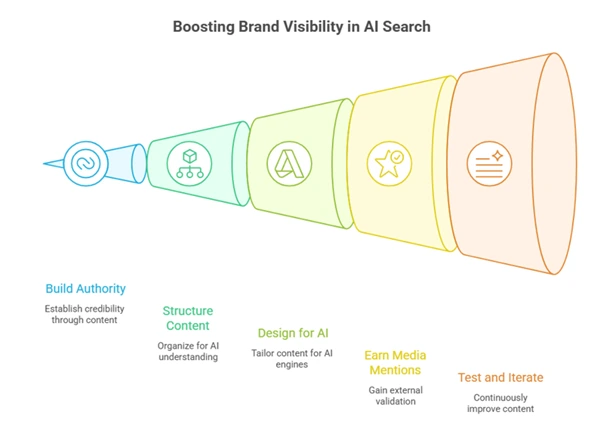
5 ways to Boost Visibility in AI Searches
Here’s how to crack AI Search and increase your odds of being surfaced:
Authority & Trust signals
First, a brand must build its authority and send out trust signals.
- Publish research, data-driven case studies & expert commentary — AI favours credible content.
- Maintain consistent author bios, credentials, and domain authority.
- Earn media coverage, guest posts, and industry mentions — the third-party sources carry weight in AI Search.
Structured Content & Schema
AIs love structure, and it’s high time, your website had a proper schema, too.
- Use schema markup, FAQ sections, well-labelled headings & tables — this helps AI parse content easily.
- Organize content in modular and hierarchical blocks so AI can extract snippets.
- Use clear definitions (e.g. “what is AI search engine?” & “what is deep search AI?”) to help AI confidently map your content to queries.
Content Design for AI Engines
Content designs need changing as AI see them differently.
- Start with user intent; address how to search in AI, what is AI-powered search, and more.
- Use expansions: define secondary keywords & adjacent concepts (for heuristic and adversarial search).
- Use internal linking to support context and depth.
- Use images, tables & infographics — AI often references visual and tabular content too.
Earned Media, Reputation & External Mentions
Natural backlinks are special, and AIs cherish them.
- Prioritize getting your brand cited by trusted media, journals & niche publications.
- Strengthen directory listings, profiles & partnerships.
- Encourage reviews and testimonials — positive reputation matters in AI reasoning.
Testing & Iteration
Keep testing new designs and perfect them.
- Experiment with different content formats (Q&A, guides, and comparisons).
- Monitor which prompts/query types lead to visibility.
- Update content over time (refreshing & expanding) — AI Search rewards freshness.
By following these 5 steps, you can ensure unchallenged AI brand visibility, which will benefit your brand in the long & short-term.
Conclusion
“Cracking AI Search” doesn’t mean gaming a rank — it means becoming a reliable voice in generative AI conversations. Visibility in this era is about mentions, citations, and authority.
To succeed:
- Reorient your metrics (mentions > ranking).
- Use structured content, schema, and definition-based writing.
- Earn media and build external credibility.
- Invest in tools to monitor AI Search visibility.
- Frame your content with knowledge of AI methods (heuristic, deep search & adversarial).
If you treat AI Search as its own ecosystem and optimize accordingly, you can turn the disruption into a competitive edge for brand visibility.
Wildnet Technologies is a leading AI Marketing agency in India that is helping brands and digital marketing agencies worldwide tackle AI search effortlessly.
If you wish to know more,
- What is LLMS.txt & Why Does It matter in the AI Search Age?
- Glossary (To keep up with Jargon)
- Digital Yum (To Upskill freely)
Connect with us now at info[@]wildnettechnologies.com and get India’s best AI marketing services.
FAQs
Question 1: What is AI-powered search?
Answer 1: AI-powered search refers to search systems powered by artificial intelligence and machine learning (such as LLMs). It understands natural language queries and synthesizes answers rather than only returning a list of links.
Question 2: How to search in AI?
Answer 2: To search in AI, formulate natural language prompts or questions, use AI engines (ChatGPT, Gemini, etc.), and iterate prompts to get more precise results.
You can always ask the AIs to personalize the answers according to your requirements, so never compromise when working with AI.
Question 3: What is AI search engine?
Answer 3: An AI search engine is a search system that uses AI models (LLMs) to return synthesized answers, not just keyword-indexed results. It’s search results are summarized answers with relevant source links.
This makes it easier for the user to get greater insights within seconds.
Question 4: How to enable Google AI Search?
Answer 4: Google’s AI Search mode (e.g. SGE — Search Generative Experience) can be enabled in Google Labs / experimental features in supported regions (if available). In India, you can use AI Mode, AI Overviews, and more without needing to enable them.
Question 5: Which AI search engine is best?
Answer 5: There’s no one-size-fits-all “best AI search engine.”
Popular ones include ChatGPT, Google’s SGE, Perplexity, and others. The best choice depends on your use case, region, and desired output style.
Question 6: What is search AI?
Answer 6: Search AI broadly uses artificial intelligence to power search — including query understanding, result ranking, and synthesis of responses.
You can use an AI-powered search engine like Google and Comet or AI chatbots like ChatGPT, Grok, Perplexity, and more.
Question 7: How to rank in AI search results?
Answer 7: “Ranking” in AI Search is less about positions and more about being cited in responses. To do that, focus on authority, structured content, precise definitions, and relevance to user intent.
Or drop us a ping…
